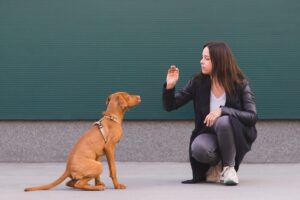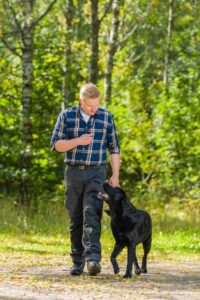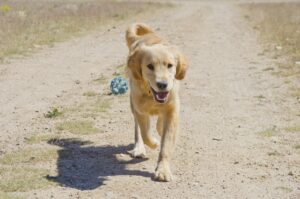Sit Basic Dog Commands

There are many ways to teach your dog how to sit. First, you can capture your dog. Simply, you will be standing in front of your dog and holding a treat. You will need to wait for your puppy to sit down before you can give them the treat. Next, encourage them to stand. Wait for them to get up again before giving another treat. Continue this process several times and encourage them to sit. Luring is the second trick. You can lure your dog by placing a treat in front of them. Just place the treat on their noses and gently lift it above their heads. They can then sit up and reach for the treat by lifting their heads. When their bottom touches the ground, give them the treat. Continue this process several times, then reward them with an empty hand. This will enable them to understand the hand signal and associate the command with “sit”. However, it is best to not physically sit your dog. This could cause them to become confused or upset.
Down

This is another command that you need to teach your dog. Be sure to not confuse them by saying “down” while you are telling them to get up from the couch. Simply hold a treat in your hands and let a small amount of it stick out. This will train them to go lower. Your pup will be able to see the treat. Then, show it to your pup and place a treat underneath in a flat hand. They will be able to reach it as many times as possible. Give it to them once they are comfortable and relaxed. Continue repeating this until they understand that their hands are on the ground and they must lie down. Make sure you include the verbal cue “down”, so they can follow your lead every time you say it. They will eventually learn to lie down when they are asked, even if you don’t give them a treat.
Stay

If your dog understands the verbal cue “stay”, they will likely remain still until you ask them to stand or give you a release cue. Staying in place is a behavior that can be sustained. This is a way to get your dog to sit still until you give a cue. First, choose the release word you want to use. Begin by sitting or standing with your dog. Next, place a treat on the ground and let them reach for it. Repeat this process several times until your pup understands that the release cue is to get up and move to your feet. Reward your furry friend for mastering the sit and release cues. Give them another treat if they remain in the sitting position as you ask. Slowly increase the amount of time between treats so they can wait longer for the release cue. It is okay if they get up and leave the room without the release cue. This simply means they aren’t ready to sit for prolonged periods of time. After they have mastered the ability to sit for a few seconds, increase their distance. Then ask them to sit down and remain there for a few seconds. Next, take a moment to step back and let them rest. Give them a treat, and then let them go. You can keep building up, making it easier for them to stay put until they release you. This can be done facing them or when you are walking away with your back to them.
However, you shouldn’t expect too much of your dog. It is important to remember that training goals can only be achieved in small steps. Therefore, it is important to have patience and take each step one at a time. Remember to keep sessions short and effective. Walking on a loose leash
The command “heel”,

which is used to train your dog in obedience, means that your dog should be walking on your left side and their head aligned with the knee of your hand as you loosely pull the leash. Your friend will be able to walk more politely if you let the leach go without pulling. Others prefer to use the words “let’s go” and “Forward” for easy walking with their dog.
Which cue do YOU prefer?
It doesn’t matter what you like, but it is important that you stick to it. It doesn’t matter if your dog walks on your right or left side. That is up to you. It is important that you keep your dog in the same place you want it to so they don’t wander off-track. First, ensure your pet is comfortable with a leash. They might initially feel odd and may bite the leash. Reward them for every time they put the leash around their neck. Hold the leash loosely on your neck and give them treats for sitting or standing next to you. Encourage them to take a step forward and then give them a treat when they do. Slowly increase the amount of leash time until your faithful friend is comfortable walking by your side. Allow them to take in the scenery as you go, and then give them the signal “let’s go!” with a happy, appreciative tone. Reward them for returning to their original position and for continuing the walk with you.
Come

This command is important if you want your dog to respond to commands, especially indoors or in quiet areas. Simply sit down with your dog and say “come.” You can also say their name to let them know you are there. Give them a treat when you give the cue and they respond accordingly. Simply drop a treat right in front of them and when they’re done, you can say their name again. Give them another treat when they look up. Continue doing this until they are familiar with what to do when you call them. Next, move away from them and start to do it from a distance. Give them a treat when they come running towards you. It is vital to not say their name too often, as they may ignore you. It is best to get closer to your dog and then move back to call them. They will respond well if you do this. When they are able to turn their heads to face you, you can gradually increase the distance. You can make it more exciting by calling their name and running to chase them. Give them a treat when they catch up to you. Continue to increase your distances and play at new locations. Do not grab your pet when they approach you. This can be confusing or frightening. If your dog seems timid or afraid, you can kneel down and offer a treat. Do not call your dog to punish him. They might be trained to associate punishment with the call. Re- ward them for responding well to your name, even if they are being mischievous.
